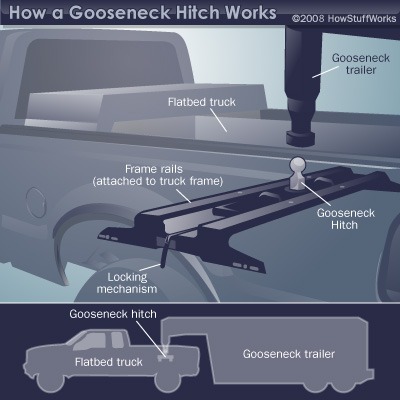When considering a new trailer, one of the most important questions to ask yourself is whether you should go with a gooseneck or a bumper tow. To help answer this question, it’s important to learn the advantages and disadvantages of both, and also consider how you’ll be using your trailer most often; will you be consistently transporting heavy machinery, or rarely hauling it? By considering which option best fits your needs, you’ll have a better ride and an overall better trailering experience. Let’s jump in:
The Bumper Pull Tow
According to Featherlite Trailers:
“The most common type of hitch is the bumper pull, also known as a drag or tagalong trailer… the trailer’s tongue fits over a ball hitch that juts out from the vehicle’s frame at the rear of the vehicle… bumper pulls are smaller than goosenecks; this means a bumper pull trailer usually costs less than a gooseneck. It also means you may not have to buy a pickup truck in order to tow a bumper pull. Depending on the trailer, a motorhome, SUV, or CUV may be suitable for hauling one.
Another advantage is the combined weight of a bumper pull trailer and vehicle is unlikely to exceed 10,001 lbs. This is usually the weight at which a trailer is declared commercial and requires a special license to haul, but you’ll want to check with your state’s Department of Motor Vehicles in case your state has lower limits.”
“There are two types of bumper pull hitches: Fixed-drawbar and receiver. Receiver hitches mount to the rear of a vehicle and a ball mount can fit inside to secure the trailer to the towing vehicle. The fixed-drawbar hitch utilizes one solid piece, allowing a trailer ball into the hitch for securement. The fixed-drawbar is generally ideal for those towing long, wide trailers whereas the receiver hitch can be used for small trailers to cargo carriers to bike racks.” (http://rvtravel.about.com)
Disadvantages of Bumper Tow Trailers:
- A bumper pull trailer will probably need a weight distribution set-up if the fully loaded weight of the trailer is greater than half the weight of your truck, but you’ll avoid that complication by going with a gooseneck trailer. (www.etrailer.com)
- A smaller trailer means less space for living quarters… and if you’re hauling horses or livestock it also limits the number of animals you can transport. (www.horseinfo.com)
The Gooseneck Tow
 The gooseneck tow is typically for the more advanced, serious tower vs. the beginner tower. This is for several reasons; first, goosenecks are more expensive. Second, they require a slightly more complex setup. However, they also allow the driver more stability and the ability to tow much larger loads. As etrailer states, “… with a gooseneck trailer, the pin weight is applied to the vehicle directly over or just in front of the rear axle of the truck which will provide much more stability which is why I’d recommend going that route.”
The gooseneck tow is typically for the more advanced, serious tower vs. the beginner tower. This is for several reasons; first, goosenecks are more expensive. Second, they require a slightly more complex setup. However, they also allow the driver more stability and the ability to tow much larger loads. As etrailer states, “… with a gooseneck trailer, the pin weight is applied to the vehicle directly over or just in front of the rear axle of the truck which will provide much more stability which is why I’d recommend going that route.”
Gooseneck trailers “appears to have a ‘neck’ that extends over the box or bed of the tow vehicle. A gooseneck uses a ball hitch that is placed into the box of the truck.” Some advantages to this type of trailer are “the down weight is over the truck axle which gives more stability. The trailer starts turning when the tow vehicle turns, cutting corners more quickly than the bumper-pull and giving a tighter turning radius (www.horseinfo.com).
Disadvantages of Gooseneck Tow Trailers:
- Most trucks don’t come with a gooseneck hitch installed, so this is an extra cost to consider when going with a gooseneck hitch over a bumper pull one. This is one of the reasons why this type of hitch and the fifth wheels that come with it are invested in down the line for RVers. (http://rvtravel.about.com)
- You won’t be able to haul one with anything less than a pickup truck, and unlike bumper pull trailers, several goosenecks are heavy enough to be classified as commercial. Gooseneck trailers also require a special hitching system, installed in the bed of a pickup truck…. You’ll need a mechanic (and some additional money) to do this. (www.fthr.com)
- Another gooseneck trailer issue is storage of the trailer itself. Since gooseneck trailers are generally larger than bumper pull trailers, storing one is a little more complicated than storing a bumper pull. (www.fthr.com)
